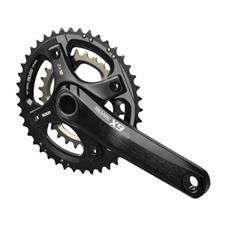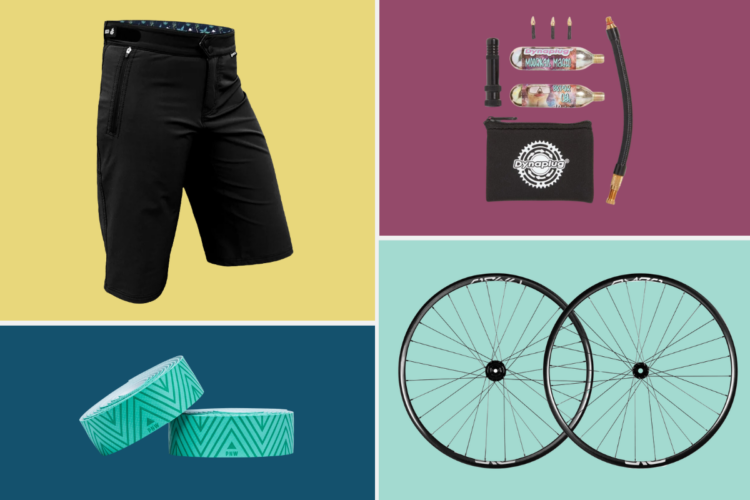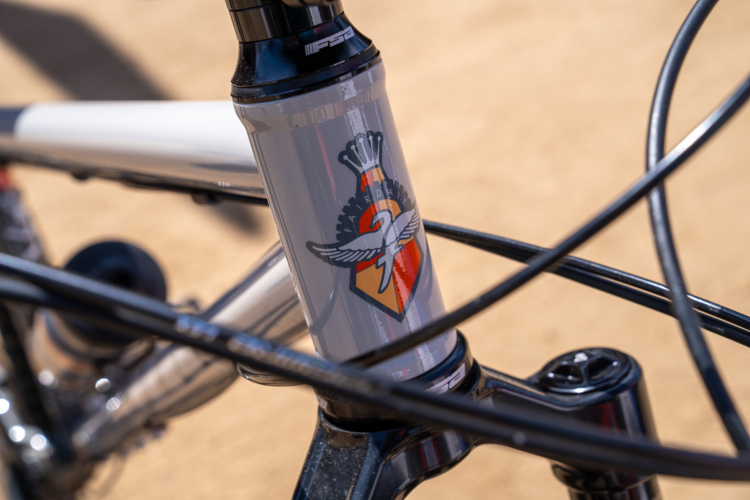You have probably heard terms like 3×9, 2×10, or 1×9 thrown around in discussions about mountain bike gearing. In case you are not familiar with the jargon, here is a quick review.
When someone says 3×9 (pronounced “three by nine”) they are referring to the setup of the chain rings and cassette on their bike. The number 3 is how many chain rings they have on the front and 9 is the number of cogs on the cassette. Therefore a 1×9 would be 1 chain ring and a 9 speed cassette, etc. You get the idea.
A typical 3×9 crankset from RaceFace.
Additionally, chain rings and cassettes come in different sizes. Both are measured by the number of teeth they have, and if you’re mathematically inclined you can use this info, along with the wheel diameter andlength of your crank arms, to calculate your total effective gear ratio. I am notmathematically inclined, so let’s just skip that part.
For years mountain bikes have employed a triple front chain ring and a 7, 8, or 9 speed cassette. This is a tried and true design and it gives you an extremely low granny gear for long, steep climbs, and a decent big ring for haulin’ the mail on flat or downhill sections.
However, there are some limitations to this setup.
Weight: Three chain rings weigh more than two … or one.
Clearance: When crossing logs, rocks, etc, the big ring can scrape, and bent or broken teeth are generally the result. (On the chain ring, not necessarily your teeth.)
Crossing Your Chain: This is discussed at length in this forum post but here are the cliff notes. Every rear derailleur has a range of gears that it can handle. It is usually expressed as a number of teeth, and on a typical 3×9 system it will be somewhat less than the difference between your largest chainring and smallest cog, or vice versa. Shifting into one of these extremes will result in poorpedaling efficiency and will accelerate wear on your chain and gears.
Derailleur Cage Length: The greater the difference between your large and small gears, the longer your derailleur cage needs to be to take up the chain slack. The longer the derailleur cage is, the more likely it is to get whacked on stuff.
One obvious solution is to just get rid of the big ring and maybe replace it with a bashguard. Many riders, especially here in Colorado, have done just that, leaving the small and middle rings. This is a workable solution, however without that big ring, long stints on the flats can be really tedious.
A ‘ghetto’ 2×9 setup with a bashguard installed.
So what is a modern mountain biker to do?
Enter the 2×10 setup!
But wait, isn’t that essentially what the bashguard setup is?
Not exactly…
A typical 3×9 setup will have something like a 44t-32t-24t chain ring setup, (t = number of teeth) and an 11-34t cassette. There are some variations such as older 8 speed cassettes with 11-30t or 32t, and newer 10 speed cassettes with 11-36t. The latter is the norm on most 29ers.
So what those clever bike engineers have done is take the traditional triple chain ring and “split the difference” with a two ring setup. The current offerings from SRAM employ a 26t-39t setup, whereas Shimano has a 26t-38t or a 28t-40t.
 Okay, I get the concept, but why do I care?
Okay, I get the concept, but why do I care?
Admittedly, a 2×10 setup is the very definition of compromise, as there isn’t as big of a big ring and the granny gear is a little less granny and a little more gear, but there are some advantages.
Weight: Comparing otherwise identical Race Face Turbine crank sets, the double shaves 55 grams off the weight of the triple.
Clearance: While not as radical as the old school two ring setup, the new style 2 speed cranks are still smaller than the traditional big ring so it will scrape less (and yes, there are bashguards for a 39t big ring).
Crossing Your Chain: This is my favorite feature. On a 2×10 setup you can use all 10 gears with either chain ring; there is no chain crossing. On the trail this simplicity is awesome.
Derailleur Cage Length: Depending on your exact setup, you can most likely get away with a shorter, mid cage rear derailleur.
I recently made the switch from 3×9 to 2×10 and I am completely sold on the concept, however, it may not be for everyone. The slightly smaller big ring isn’t much of an issue, but out here in the mountains the lack of a true granny gear is very noticeable. I found myself needing to keep up a slightly higher cadence in order to avoid stalling out when climbing. It was brutal at first, but once I got used to it, I really liked it. And after a month or so, I found myselfsignificantlyfaster on climbs.
There is nothing wrong with a traditional 3 chain ring approach or a homebrew 2x with a bashguard, but if you’re bored with your current setup and want to shave a little weight while losing some complexity, then you should definitely give 2×10 a try.
[see_also id=”196402″][/see_also]





















